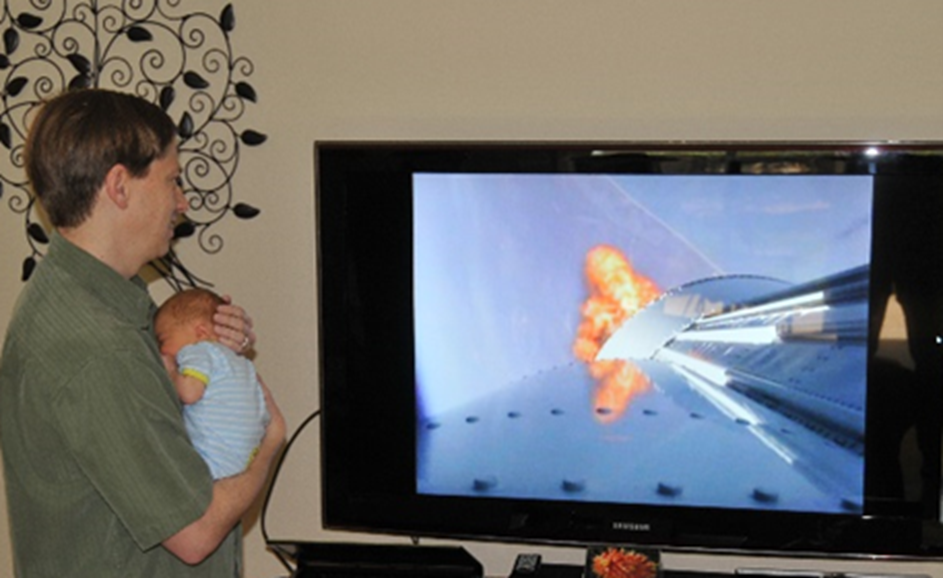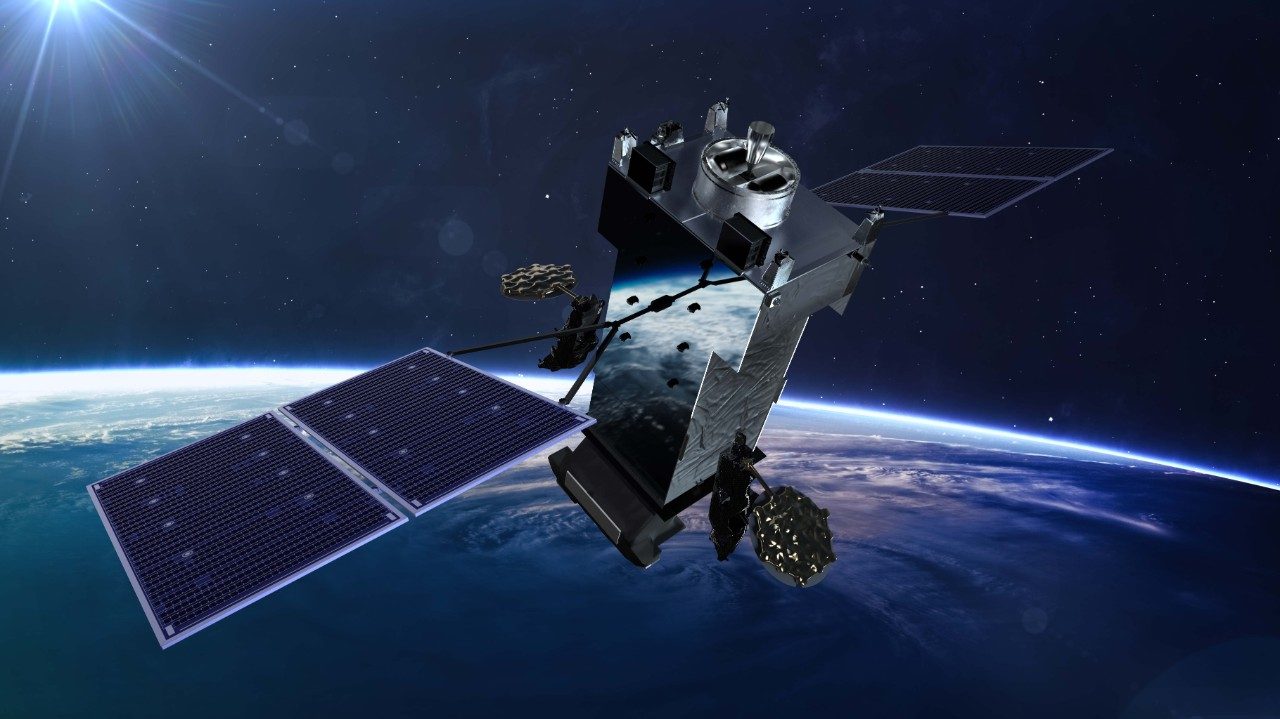Lockheed Martin’s Space Based Infrared System (SBIRS) program has played a major role in Johnathon Caldwell’s 25-year career at the company. For several of those earlier years, he managed the teams that built the early missile warning satellites. Now, as vice president and general manager of Military Space, he’s leading the business area as it prepares for the final SBIRS satellite launch on Aug. 4.
SBIRS GEO-6 will be the latest satellite to join the U.S. Space Force’s orbiting missile warning constellation equipped with powerful scanning and staring surveillance sensors. The 24-7, always-on, Overhead Persistent Infrared (OPIR) guardians detect missile launches, support ballistic missile defense, expand technical intelligence gathering and bolster situational awareness on the battlefield for the U.S. military.
SBIRS Launches Mark Formative Moments
SBIRS has been ever-present in Caldwell’s life. The program’s launches have not only represented professional milestones for him, but many have also coincided with significant moments in his personal life.
In 2011, Caldwell became a first-time father just five days before the launch of the first SBIRS satellite, GEO-1, for which he was serving as the pointing control payload senior manager. In that position, Caldwell managed a team developing the SBIRS follow-on pointing payload, and he had a role on the launch management team because he had previously helped build the GEO-1 and GEO-2 payloads.
When it came time to watch the GEO-1 launch, Caldwell held his son and reflected on all the hard work that went into getting that satellite off the ground. He cherishes a photo of that precious moment for what it represents, and now, as VP/GM, Caldwell enjoys sharing that image with his team as he stresses the importance of work-life integration.

Johnathon Caldwell, vice president and general manager of Lockheed Martin Military Space, holding his newborn son as he watches the launch of SBIRS GEO-1 in 2011.
“It was one of those amazing times that was also challenging, personally and professionally,” said Caldwell. “I was feeling the joy of a new baby, and we were also working so hard to get the first GEO satellite launched.”
As if welcoming one baby before a launch wasn’t enough to handle, two years later, Caldwell’s wife coincidentally gave birth to twins six weeks before the launch of SBIRS GEO-2. By that time, Caldwell was the launch campaign manager, a leadership role in which he was responsible for bringing the entire launch activity together, from space, to ground, to customers.
“I had a lot of folks ribbing me, saying, ‘For the first launch, you had one kid, the second launch, you had two kids, what’s your role going to be for SBIRS GEO-3?’ Caldwell joked. “There was a lot of good humor with that, so I went and made sure I became the chief engineer for another program – GPS – so I didn’t have to address that conversation about triplets.”
Balancing the birth of his children and the launches of key national security assets could have been overwhelming, but Caldwell credits the support of his wife and other loved ones in his community for helping him manage the pressure.
“My wife was part of the team, whether she knew it or not, because she was doing the hard work of taking care of our young kids while my team and I were busy taking care of SBIRS,” said Caldwell. “It’s a fun story to share with folks because I think sometimes we don’t think about what we have to balance in getting our mission done, and the fact is that our team isn’t just the people we see around us at work. It’s the people in our communities that form our support structures that enable us to do our best work.”

Johnathon Caldwell, vice president and general manager of Lockheed Martin Military Space, with his wife and their children.
A Time to Reflect
When Caldwell returns to Cape Canaveral, Florida, to witness the launch of SBIRS GEO-6 – the last in the series – he hopes the team who worked to field the capability will take the opportunity to pause and reflect on all the great work that’s gone into the program.
“This is a point in time when we can stop and recognize that through all the ups and downs, this work wouldn’t have been accomplished without so many people along the way,” said Caldwell. “I really want people to take the time to express appreciation for the large community that it takes to do something as amazing as missile warning for the U.S. and its allies.”
Looking Forward
Caldwell also believes the GEO-6 launch will serve an excellent time to look forward at what’s next for Lockheed Martin in terms of missile warning capabilities.
“It’s like getting over a mountaintop and seeing that you have another summit to conquer,” he said. “And so, you have to look forward as well.”
Caldwell says the launch marks a pivotal point for where we need to take future systems, like Next Generation Overhead Persistent Infrared Geosynchronous Earth Orbit (NGG) early missile warning satellites. NGG is the Space Force’s new, advanced space-based missile warning system that incorporates improved warning capabilities, as well as enhanced resiliency and cyber hardening. NGG will provide early warning for the defensive “kill chain” that protects the U.S. and our armed forces from missile threats. The new system responds to challenges from rival nations that increasingly seek to erode our country’s space advantages.

Lockheed Martin’s Next Generation Overhead Persistent Infrared Geosynchronous Earth Orbit (NGG) Block 0 early missile warning satellite.
Lockheed Martin is under contract with the Space Force’s Space Systems Command (SSC) for three NGG Block 0 satellites, with the first of the satellites on track for a 2025 launch.
Digital Enhancements for Improved Capabilities
Lockheed Martin’s NGG program is embracing digital transformation as a way to deliver next generation capabilities quicker and faster. The company is using digital engineering capabilities including digital twin, artificial intelligence and machine learning technologies, along with augmented reality to speed production, integration and test and enabling the rapid transition to operations.
“If you look at NGG now, we are on track,” said Caldwell. “We’re driving hard for a launch in 2025, and that’s what the nation needs. In the OPIR world, the team members have every expectation that we’ll be able to execute on cost and schedule. We ought to be able to overcome technical challenges and field systems that provide amazing capabilities.”
SBIRS GEO-6 is a steppingstone toward achieving the resilient missile warning that will be provided by NGG. Like SBIRS GEO-5 and GEO-6, the NGG satellites built by Lockheed Martin will be based on the LM 2100 Combat Bus™, a militarized version of our modernized, modular LM 2100™ space vehicle with greatly enhanced resiliency.
“I think SBIRS GEO-6 provides a great connective tissue between the history of missile warning and future of where we’re going to protect the country,” said Caldwell.
SBIRS GEO-6 is expected to launch into orbit aboard a ULA rocket from Cape Canaveral Space Force Station in the early morning of Thursday, Aug. 4. You can watch the launch live here starting at 4:09 a.m. ET.




